Hydrogen-powered plane takes to the skies over the Cotswolds
>
A hydrogen-powered plane that could usher in an era of environmentally-friendly, ‘guilt-free flying’ has taken to the skies for the first time.
Aircraft firm ZeroAvia conducted the successful test flight of its Dornier 228 plane on Thursday afternoon at Cotswold Airport in Kemble near Cirencester, Gloucestershire.
The 19-seater plane has a hydrogen-electric engine on its left wing, while on the other is a turboprop – a turbine engine that drives an aircraft propeller.
The Anglo-American firm say its modified Dornier 228 is the world’s largest aircraft powered by a hydrogen-electric engine.
Aircraft firm ZeroAvia conducted the successful test flight of its Dornier 228 plane on Thursday afternoon at Cotswold Airport in Kemble near Cirencester, Gloucestershire. Pictured is the craft shortly after launch
On board the plane are hydrogen fuel cells, which create power by mixing hydrogen and oxygen – which is provided by the air – via a chemical reaction.
The only waste product produced by this process is water, unlike traditional aviation which is a major contributor to greenhouse gas emissions.
ZeroAvia is on track to conduct commercial flights using only hydrogen fuel cell power by 2025 – a step towards air travel without greenhouse gas emissions.
It wants to do 300-mile passenger flights with a nine to 19 seat aircraft by 2025, and up to 700-mile range in 40 to 80 seat aircraft by 2027.
Some of ZeroAvia’s investors include big commercial airlines including American and United Airlines, which could use the firm’s technology to run their own eco-friendly flights later this decade.
‘This is a major moment, not just for ZeroAvia, but for the aviation industry as a whole, as it shows that true zero-emission commercial flight is only a few years away,’ said Val Miftakhov, founder and CEO of ZeroAvia.
‘The first flight of our 19-seat aircraft shows just how scalable our technology is and highlights the rapid progress of zero-emission propulsion.
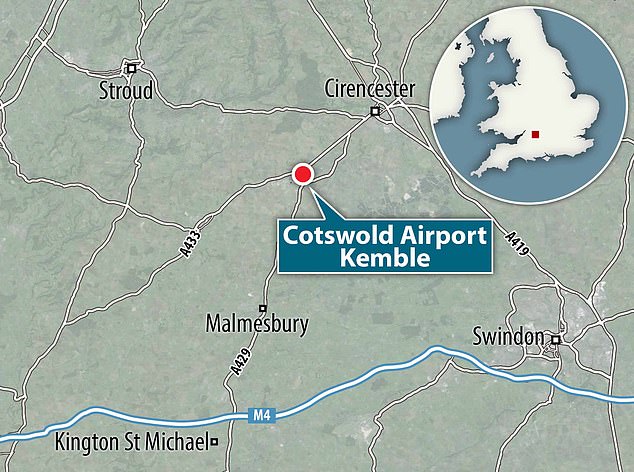
Cotswold Airport, previously RAF Kemble, is located near the village of Kemble near Cirencester, Gloucestershire
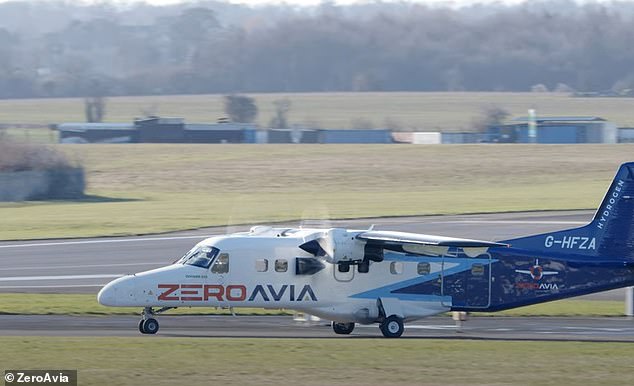
The twin-engine aircraft was retrofitted to incorporate ZeroAvia’s hydrogen-electric engine on its left wing, operated alongside the Honeywell TPE-331 turboprop engine on the right
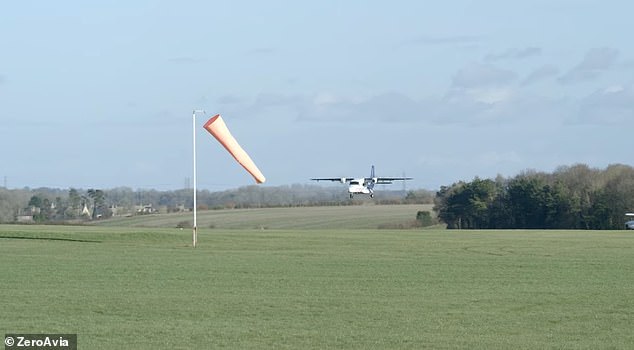
The plane comes in to land after a successful take-off, a full pattern circuit, and landing, lasting about 10 minutes
‘This is only the beginning – we are building the future of sustainable, zero climate impact aviation.’
At 13:35 GMT on Thursday the aircraft completed take-off, a full pattern circuit, and landing, lasting around 10 minutes in total.
The twin-engine aircraft was retrofitted to incorporate ZeroAvia’s hydrogen-electric engine on its left wing, operated alongside the Honeywell TPE-331 turboprop engine on the right.
On the left wing, the hydrogen-electric engine comprises two fuel cell stacks, with lithium-ion battery packs providing additional power support during take-off.
This supplementary lithium battery power was not powered by hydrogen, but the firm aims to test fly aircraft using only hydrogen fuel cells by the end of the year.
Currently, hydrogen tanks and fuel cells are housed inside the plane’s cabin, but these will be moved to the plane’s exterior and the seats restored for passenger flights.
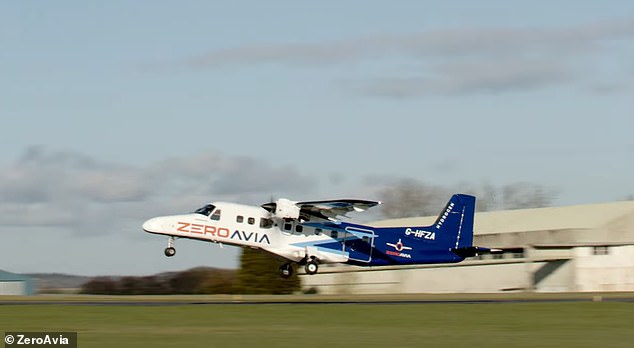
Some of ZeroAvia’s investors include big commercial airlines including American and United Airlines, which could use the firm’s technology to run its own eco-friendly flights

Currently, hydrogen tanks and fuel cells are housed inside the plane’s cabin, but these will be moved to the plane’s exterior and the seats restored for passenger flights
Although it’s also supplemented by a turboprop, the firm aims to perform commercial flights using only hydrogen fuel cell power by 2025.
Following Thursday’s flight, the Dornier 228 will conduct more test flights from Cotswold Airport, followed by demo flights from other airports.
ZeroAvia’s efforts are part of the HyFlyer II project, a R&D programme backed by the UK government to develop low-emissions passenger planes.
Secretary of State for Business, Grant Shapps, said: ‘Today’s flight is a hugely exciting vision of the future – guilt-free flying and a big step forward for zero-emission air travel.
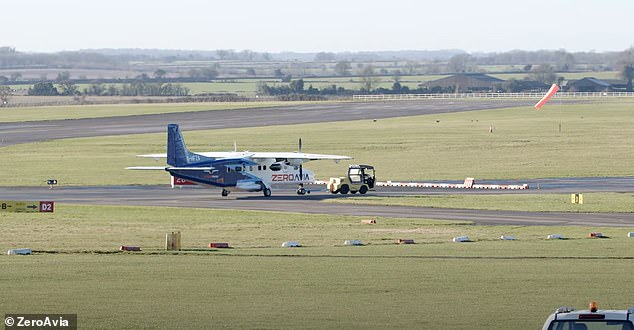
Following Thursday’s flight, the Dornier 228 will conduct more test flights from Cotswold Airport followed by demo flights from other airports
‘The UK is a world leader in green aviation technology, and the global shift to cleaner forms of flight represents a huge opportunity to secure growth and jobs for our country.’
ZeroAvia has already flown a six-seater hydrogen-electric powered prototype plane, the Piper M-class, which has now completed more than 30 flights since its first back in September 2020.
However, not all of its test runs have been successful; in April 2021, one of its planes, a modified hydrogen-powered Piper Malibu Mirage two-seater, lost power and crashed after launching from Cranfield Airport, Bedfordshire.
An investigation from the government’s Air Accidents Investigation Branch (AAIB) found the hydrogen technology wasn’t to blame.
Although no one was hurt, the left wing detached and landing gear collapsed after a forced landing when power to the electrical motors was lost.
